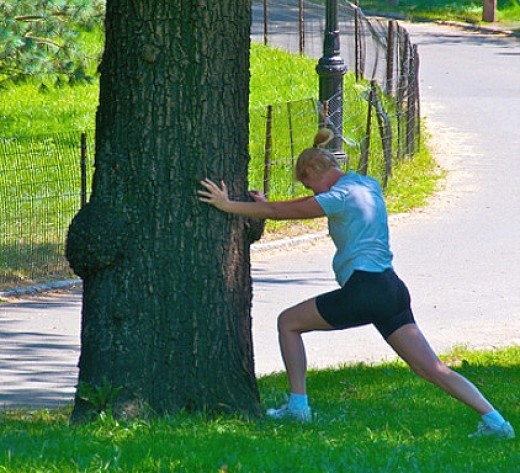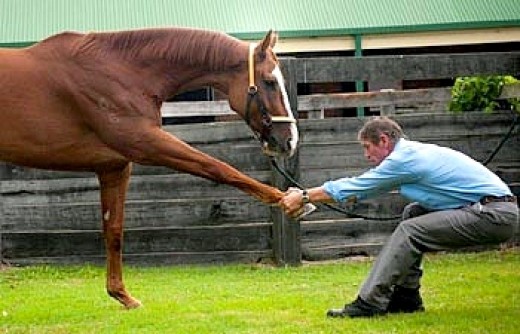Stretching Exercises Before a Run or Workout May NOT Reduce Injuries
Despite all the hype and preening gestures, all the stretching people do before running and other exercises, to reduce the risk of injury, has been shown to be largely a myth. Recent research studies and reviews have shown that the warm-up is much more important.
The findings from a study of over 2,700 volunteers who ran 10 or more miles per week found few if any benefits, despite the long held beliefs of amateur and professional athletes and exercise enthusiasts.
The study presented to the 2011 Annual Meeting of the American Academy of Orthopaedic Surgeons (AAOS) is one of the first properly controlled study of the link between injury risk and pre-run stretches.
The study found that the risk of injury was about the same for men and women, irrespective of whether they were high or low mileage runners, and applied similarly to all age groups.

Finding your ideal stride length and pace are also very important for reducing the risks of injuries
However the rates of injuries did correlate with weight and the incidence of previous injuries in the last 4 months.
The nearly 3000 runners were randomly assigned to two groups:
- Group1 who stretched for three to five minutes immediately before running - stretching their hamstrings, quadriceps and gastrocnemius/soleus muscle groups.
- Group 2 a non-stretch group.
The study found that stretching before running did not prevent nor cause injury. Essentially there was no difference between the two groups -stretching did not reduce the injury rate.
The study found that routine was very important - runners who switched their routines from stretch to no-stretch and vice versa were more likely to experience an injury than those who did not switch. This particularly applied to the runners who normally pre-stretched before running, but were placed in the non-stretch group.
The study found that a shift in a regimen was more important than the regimen itself.
Why do People Stretch before and after exercise?
Stretching has been advocated for many years as a crucial part of any fitness program to improve performance, decrease the risk of injury and prevent soreness after exercise. While researchers continue to look at the benefits and pitfalls of stretching, there is still limited (and conflicting) evidence to sort out these claims.
Stretching and Soreness - A review of 10 previous studies conducted at the University of Sydney, found that stretching before exercise did not prevent post-exercise muscle soreness. This study also found that stretching immediately before exercise could be shown to prevent either acute or long term overuse injuries.
Warm-Up versus Stretching - Much of the confusion in the scientific literature is caused by a misinterpretation of research on the warm-up. Recent studies have found that warming up that includes stretching was beneficial, and the results suggest that it is the warm up that prevents injuries rather than the stretching itself.
Perhaps athletes should devote more of their pre-exercise routine to the warm up rather than stretching.
Stretching and Performance - A systematic and critical review of the literature found that a short period of stretching does not improve force or jump height of athletes tested. The results for running speed were inconclusive. Regular stretching during training was shown to improve jump height, force and speed, but there is no evidence that it improves running economy.
Other studies have shown that stretching recommendations are clouded by misconceptions and conflicting research findings and claims. This may partially be explained by the type of sports activity involved.
Sports that involve bouncing and jumping activities with many of stretch-shortening cycles and straining, such soccer and football require a muscles and tendons that are supple allowing them to store and release elastic energy that is required or such sports.
Pre-stretching may make the muscle and tendons more compliant and decrease the risk of injury. Stretching exercise in these sports is designed to increase the compliance of the muscle-tendon unit and may be beneficial.
Recent scientific studies have shown that stretching programmes can increase the actual viscosity of the tendon and make it more supple.
But whether a short session of stretching before the game is effective is unknown, but the long-term benefits of stretching during training are likely to be more effective.
In contrast, for sports that require low-intensity, or limited stretch-shortening cycles (e.g. running, jogging, walking, cycling and swimming) there is less need for a very compliant muscle-tendon unit. Most of the work required is done by active muscle contractions that is directly transferred by the tendon to the bone in the skeleton to do the exercise.
Therefore, stretching may not be advantageous or necessary for running, swimming and cycling.
This concept is generally supported by a range of scientific studies that generally show few benefits injury for preventing injuries in these sports. © janderson99-HubPages
Various studies have provided conflicting claims about the benefits of stretching, and some studies have suggested that it may increase the risk of injury.
For example in a study of some 1500 competitors in the Honolulu Marathon, about half of all male runners who stretched regularly developed injuries over a one-year period, while only about a third of male runners who didn't stretch developed injuries. The study claimed that stretching increased the risk of injury by about 33%.
It has been suggested that these results may be related to when and how the stretching was conducted.
However in another study a group of runners were instructed how to properly warm up, cool down and stretch, while a second group of similar runners received no instruction at all.
Over several months, the injury rates of the two groups were identical so the form instructions on how to warm-up, stretch and cool-down provided no protective benefit.
A study of military recruits who stretched before and after training showed significantly lower rates of muscle-related injuries compared with recruits that did not stretch, but there was no difference in the rate of bone or joint injuries. Many studies showed similar conflicting results and outcomes.
Another study - suggested that the warm-up is more important than stretching:
- Stretching before a workout or an event is unlikely to be of benefit and a warm-up should be sufficient.
- Perform a warm-up for at least 10 minutes before you start your proper exercise session using an activity similar to your main activity but at lower intensity.
- Several light repetitions of the warm-up exercise or 5 to 10 minutes of light running on a treadmill, jogging or cycling will get the blood flowing for most exercises including weight training.
- A warm-up without stretching is most likely all you need before a competition event.
Conclusion
The research is very confusing but suggests that you stick to your regular routine and that the warm-up may be more important for reducing injuries for endurance sports such as running, cycling and swimming.
Update!
New studies have suggested that stretching before exercise is not usually necessary and could be counterproductive for exercises and sports requiring sudden burst of power.
Researchers at the University of Zagreb re-examined hundreds previously published studies and found that stretching before exercise actually reduced strength by about 5%, and explosive performance of muscles fell by about 3%.
Why this occurs is unknown.
It is better to warm-up dynamically, rather that do static stretches.
The idea is to move the muscles you are going to use during your workout through a series of work-level stages.
This this more of a warm-up than a stretching session.
Other studies have reached the same conclusion.




